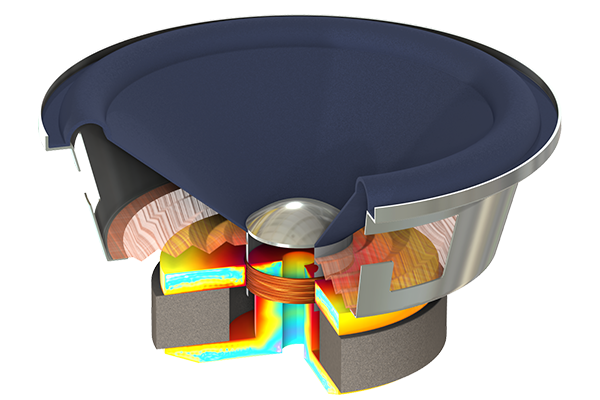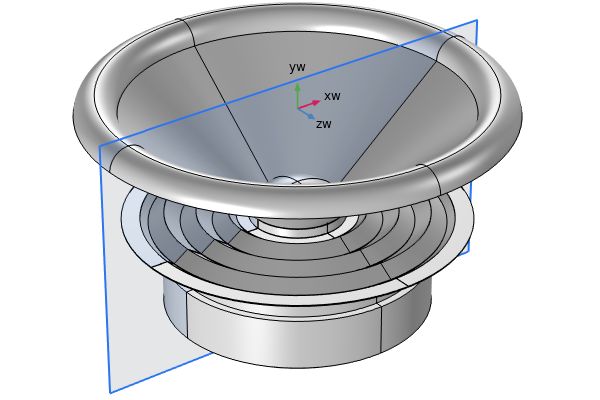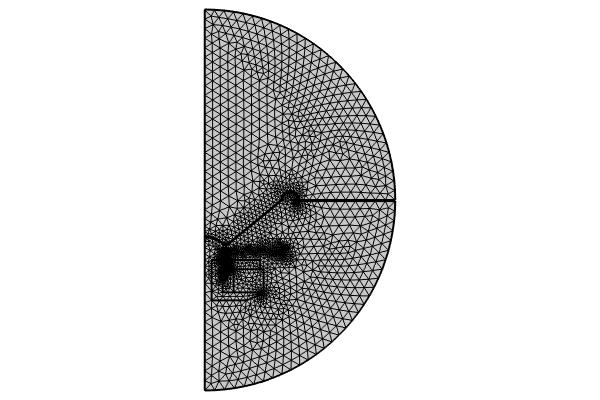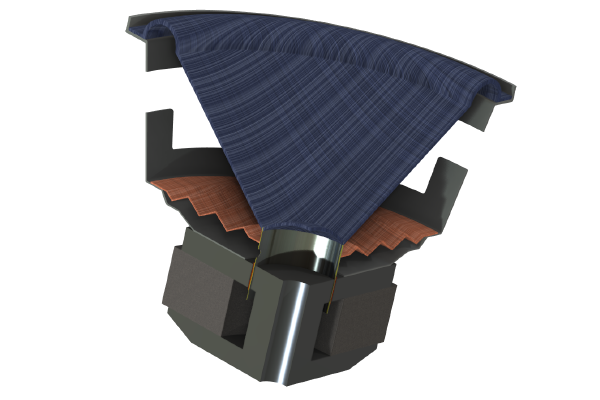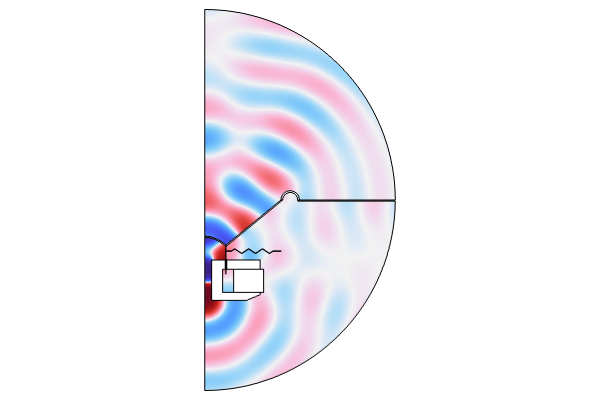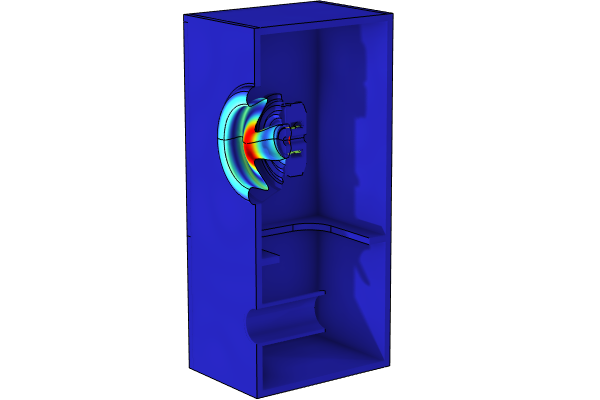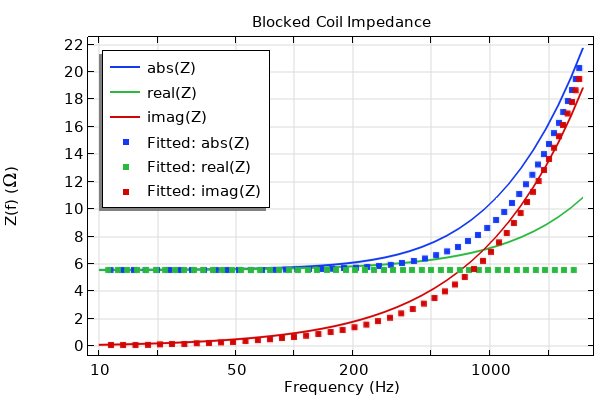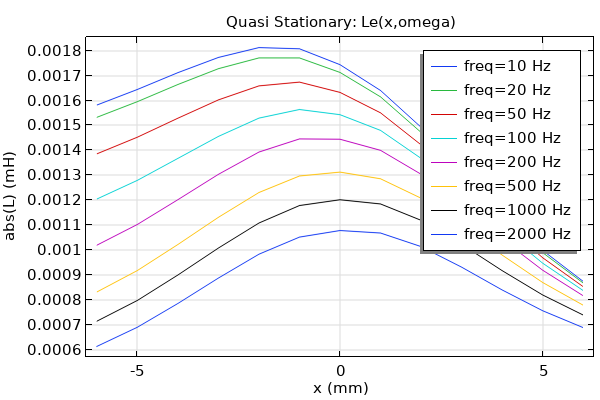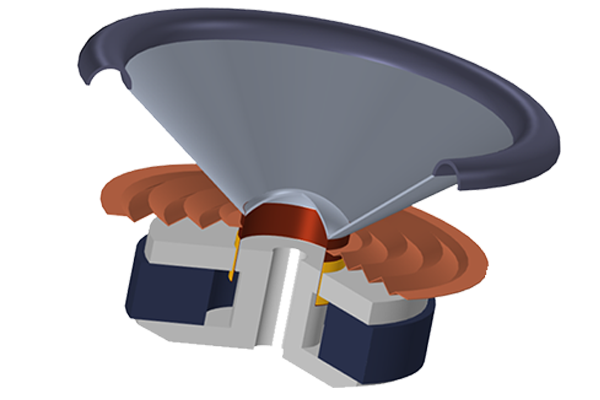Supplement A: Equations
There are several interfaces in COMSOL Multiphysics® that are frequently used for electrovibroacoustics modeling, including the Magnetic Fields, Pressure Acoustics, Solid Mechanics, and Thermoviscous Acoustics interfaces. The governing equations and mathematical formulations for each of these interfaces are listed and described below. The formulations adopted for the electrovibroacoustics multiphysics couplings are also included.
The Magnetic Fields Equations
The Magnetic Fields interface solves Maxwell’s equations and is formulated using the magnetic vector potential, .
The equations solved in a time-dependent analysis are:
,
,
, and
,
where:
• = electric conductivity
• = free space magnetic permeability
• = magnetization vector
• = velocity of the moving coil
• = an externally generated current density
• = magnetic flux density
• = magnetic field intensity
• = electric field intensity
• = electric displacement field
The total electric current density, , includes the contribution from the induced electric field,
.
The time-harmonic equations solved in the frequency domain are:
,
,
, and
,
where is the angular frequency.
The Pressure Acoustics Equations
For time-dependent analysis, the governing equation that solves for pressure waves in the fluids is the scalar wave equation,
,
where:
• = total acoustic pressure
• = density
• = speed of sound
The monopole domain source, , and the dipole domain source,
, provide an option to add a mass source or a domain force source when applicable. They are both set to zero by default.
The time-harmonic formulation solved in the frequency domain is the inhomogeneous Helmholtz equation,
,
where is the angular frequency. The subscript
to
and
refers to the fact that the density and speed of sound may be complex-valued for lossy fluid media.
The Solid Mechanics Equations
The governing equation that is solved for elastic waves in the solids is given by Newton’s second law of motion. COMSOL Multiphysics® uses the material frame formulation, i.e., a Lagrangian version of the equation. In the time domain, it reads:
,
where:
• = mass density
• = displacement field
• = identity tensor
• = deformation gradient
• = stress tensor
• = body force
The time-harmonic formulation solved in the frequency domain is:
,
where:
• = angular frequency
• = phase of the body force
The Thermoviscous Acoustics Equations
In a full thermoviscous acoustics model, the equations solved are the first- and second-order perturbation formulations of the Navier–Stokes equations in quiescent background conditions, including the continuity, momentum, and energy equations. In the time domain, they read:
,
,
, and
,
where:
• ,
,
, and
= respective acoustic variations of pressure, velocity, temperature, and density
• ,
, and
= background pressure, temperature, and density, respectively
• = dynamic viscosity
• = bulk viscosity
• = (specific) heat capacity at constant pressure
• = (isobaric) coefficient of volumetric thermal expansion
• = thermal conductivity
• = isothermal compressibility
• and
= a volume force and a heat source, respectively
The time-harmonic equations solved in the frequency domain are:
,
,
, and
,
where is the angular frequency.
Multiphysics Coupling Equations for Electrovibroacoustics
The Lorentz Coupling
To implement a multiphysics coupling between the the Magnetic Fields interface and the Solid Mechanics interface the Lorentz Coupling feature (available up to version 6.1) can be used or the Magnetomechanics Coupling feature, with Only use Lorentz force enabled, can be used. It passes the Lorentz force from the Magnetic Fields interface to the Solid Mechanics interface and passes the structural velocity, which leads to the induced electric field, from the Solid Mechanics interface to the Magnetic Fields interface. The Lorentz force and the induced electric field are calculated using these equations:
and
,
where:
• = electric conductivity
• = applied electric field
• = velocity of the moving coil
• = magnetic flux density
• = induced electric field
The total electric current density, , includes contributions from both the applied and induced electric fields and is used to calculate the Lorentz force,
.
The Acoustic-Structure Boundary Coupling
The Acoustic-Structure Boundary feature is a multiphysics coupling used to connect a Pressure Acoustics model to any structural component. The coupling includes the fluid load on the structure and the structural acceleration as experienced by the fluid. Mathematically, the condition on a fluid–solid interface reads:
,
where:
• = surface normal
• = structural acceleration
• = load (force per unit area) experienced by the structure
The Acoustic-Structure Boundary coupling can also be used to couple a Pressure Acoustics model with a Shell model. When the shells are interior structures with fluid on both sides, a slit is added to the pressure variable and care is taken to couple the up and down sides
such that the acoustic load is given by the pressure drop across the thin structure. The and
subscripts refer to the two sides of the interior boundary.
The Acoustic-Thermoviscous Acoustic Boundary
The Acoustic-Thermoviscous Acoustic Boundary feature couples a Thermoviscous Acoustics interface with a Pressure Acoustics interface.
The coupling prescribes continuity in the total normal stress (dynamic condition) and total normal acceleration (kinematic condition) for the mechanical part. An adiabatic condition is prescribed for the total temperature to match the physical assumptions of the pressure acoustics formulation. In the time domain, the coupling reads
.
For clarity, the pressure variable is denoted for thermoviscous acoustics and
for pressure acoustics. In the frequency domain, the first equation becomes
.
The Thermoviscous Acoustic-Structure Boundary
This feature is used to couple a Thermoviscous Acoustics interface with any structural component. The coupling prescribes continuity in the displacement field at the fluid–structure boundaries,
or
,
where:
• = total fluid velocity (including a background component if applicable)
• = structure displacement
The first equation is in the time domain, and the second equation is in the frequency domain. This coupling results in the stress also being continuous across the boundary. The condition for the total temperature, , can be set to either isothermal or adiabatic.
请提交与此页面相关的反馈,或点击此处联系技术支持。

